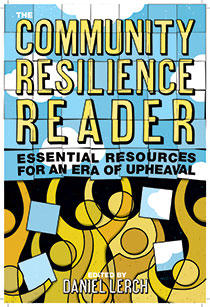 Communities must remain resilient to weather change, a recent book explores this issue:
Communities must remain resilient to weather change, a recent book explores this issue:
The sustainability challenges of yesterday have become today’s resilience crises. National and global efforts have failed to stop climate change, transition from fossil fuels, and reduce inequality. We must now confront these and other increasingly complex problems by building resilience at the community level. But what does that mean in practice, and how can it be done in a way that’s effective and equitable?
The Community Resilience Reader offers a new vision for creating resilience, through essays by leaders in such varied fields as science, policy, community building, and urban design. The Community Resilience Reader combines a fresh look at the challenges humanity faces in the 21st century, the essential tools of resilience science, and the wisdom of activists, scholars, and analysts working with community issues on the ground. It shows that resilience is a process, not a goal; how resilience requires learning to adapt but also preparing to transform; and that resilience starts and ends with the people living in a community. Despite the formidable challenges we face, The Community Resilience Reader shows that building strength and resilience at the community level is not only crucial, but possible.
From Post Carbon Institute, the producers of the award-winning The Post Carbon Reader, The Community Resilience Reader is a valuable resource for students, community leaders, and concerned citizens. (Island Press)
A long list of writers have contributed chapters, helping us understand the predicaments, tools, and action to take:
PART I: Understanding Our Predicament
Chapter 1. Six Foundations for Building Community Resilience | Daniel Lerch
Chapter 2. The Environmental Crisis: The Needs of Humanity Versus the Limits of the Planet | Leena I
Chapter 3. The Energy Crisis: From Fossil Fuel Abundance to Renewable Energy Constraints | Richard Heinberg
Chapter 4. The Economic Crisis: The Limits of 20th Century Economics and Growth | Joshua Farley
Chapter 5. The Equity Crisis: The True Costs of Extractive Capitalism | Sarah Byrnes and Chuck Collins
Chapter 6. The Roots of Our Crises: Does Human Nature Drive Us Toward Collapse? | William Rees
PART II: Gathering the Needed Tools
Chapter 7. Systems Literacy: A Toolkit for Purposeful Change | Howard Silverman
Chapter 8. A Crash Course in the Science of Sustainability | Margaret Robertson
Chapter 9. A Crash Course in the Science of Resilience | Brian Walker and David Salt
Chapter 10. Pulling It All Together: Resilience, Wisdom, and Beloved Community | Stephanie Mills
PART III: Community Resilience in Action
Chapter 11. Energy Democracy | Denise Fairchild and Al Weinrub
Chapter 12. Building Community Resilience at the Water’s Edge | Rebecca Wodder
Chapter 13. Food System Lessons from Vermont | Scott Sawyer
Chapter 14. Learning Our Way Toward Resilience | William Throop
Chapter 15. Beyond Waste: Sustainable Consumption for Community Resilience | Rosemary Cooper
Chapter 16. Resilient Streets, Resilient Cities | Mike Lydon
Chapter 17. Community Resilience and the Built Environment | Daniel Lerch
Chapter 18. Conclusion: Where to Start | Asher Miller
Those with their heads buried in the sand with respect to climate change isn’t the target audience, but the rest of us are.
— Steve Patterson


 Communities must remain resilient to weather change, a recent book explores this issue:
Communities must remain resilient to weather change, a recent book explores this issue: